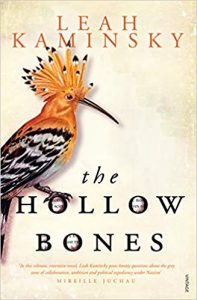The Hollow Bones
 It’s not every day you find yourself prowling around the basement of a natural history museum, being stared at by stuffed armadillos and long-extinct Tasmanian tigers. Then again, while researching THE HOLLOW BONES, I kept falling down the most remarkable rabbit holes, never quite knowing where they might lead.
It’s not every day you find yourself prowling around the basement of a natural history museum, being stared at by stuffed armadillos and long-extinct Tasmanian tigers. Then again, while researching THE HOLLOW BONES, I kept falling down the most remarkable rabbit holes, never quite knowing where they might lead.
The idea for my current book appeared while writing my debut novel, THE WAITING ROOM, a story which explored the role doctors have played historically in war, often being responsible for many of the atrocities committed during World War II, in particular.
Being from a medical and scientific background myself, I felt morally compelled to try and understand what might underpin the moral transgression of those trained to heal. I came across Welteislehre, or World Ice Theory, a strange notion postulated by a steam train engineer called Hanss Hörbinger back in 1912, in which the building block of the universe was the ice crystal and the world made of ice. This weird notion was adopted by Hitler as the pseudoscientific platform of the Third Reich, discounting many giants of scientific theory such as Isaac Newton and Albert Einstein as ‘Jewish physicists’. In its day, World Ice Theory was popularised through the media, major societies and public lectures and attracted a huge following.
Himmler, the head of the Gestapo and the SS, latched onto these early #FakeFacts, which proposed that an ancient icy moon once fell to earth in the area of the Himalayas, where the city of Atlantis was buried. The Aryan warrior race, who the Nazis believed to be their ancestors, were supposed to have emerged from the depths of their icy homes to interbreed with the ancient Tibetans.
In 1936, Himmler invited a young ornithologist, zoologist and crack hunter, Ernst Schäfer, to lead an expedition of SS scientists into Tibet, to search for these traces of the Aryan race, from which he believed the German Volk originated. In 1938, Ernst Schäfer set off with his team to explore the secrets of Tibet, a land which very few foreigners had hitherto been allowed to enter. All this formed the bedrock for my novel. Schäfer had been on two previous joint German-US expeditions with the Academy of Natural Sciences in Philadelphia.
Which brings us back to what I was doing wandering around the basement there in 2016. When I was on book tour in the US with my first novel, I visited their library archives and found a trove of material – letters, photographs and field diaries – which Schäfer had left behind.
It was then that the librarian introduced me to the curator, and I was fortunate enough to be shown the range of specimens Ernst Schäfer had brought back from his forays in the Far East. That was when I came face to face with a four-month-old panda the German scientist had shot and brought back from the Kham Forests of Tibet. This creature insisted on becoming a plaintiff call from the wild in my story. That, along with the intriguing and well-hidden love story between Schäfer and his young wife, Herta, made for a whacky rollercoaster ride into the world of 1930s Germany and Tibet.
I wrote the HOLLOW BONES essentially to give a voice to the voiceless. Playing the role of Schäfer’s moral conscience, Herta reminds her wayward zoologist husband: ‘It’s the animals who make us human.’
© Leah Kaminsky 2019
—
Her debut novel The Waiting Room won the prestigious Voss Literary Prize (Vintage Australia 2015, Harper Perennial US 2016). We’re all Going to Die has been described as ‘a joyful book about death’ (Harper Collins, 2016). She edited Writer MD (Knopf US, starred on Booklist) and co-authored Cracking the Code (Vintage 2015). Stitching Things Together was a finalist in the Anne Elder Award. The Hollow Bones is forthcoming in 2019 (Vintage Australia). She holds an MFA in Writing from Vermont College of Fine Arts.
Find out more about her on her website http://leahkaminsky.com
Follow her on Twitter https://twitter.com/leahkam
HE HOLLOW BONES, Leah Kaminsky
 The Hollow Bones implores us to pay careful attention to the crucial lessons we might learn from our not-too-distant history.
The Hollow Bones implores us to pay careful attention to the crucial lessons we might learn from our not-too-distant history.
‘I remember you once told me about mockingbirds and their special talents for mimicry. They steal the songs from others, you said. I want to ask you this: how were our own songs stolen from us, the notes dispersed, while our faces were turned away?’
Berlin, 1936. Ernst Schäfer, a young, ambitious zoologist and keen hunter and collector, has come to the attention of Heinrich Himmler, who invites him to lead a group of SS scientists to the frozen mountains of Tibet. Their secret mission: to search for the origins of the Aryan race. Ernst has doubts initially, but soon seizes the opportunity to rise through the ranks of the Third Reich.
While Ernst prepares for the trip, he marries Herta, his childhood sweetheart. But Herta, a flautist who refuses to play from the songbook of womanhood and marriage under the Reich, grows increasingly suspicious of Ernst and his expedition.
When Ernst and his colleagues finally leave Germany in 1938, they realise the world has its eyes fixed on the horror they have left behind in their homeland.
A lyrical and poignant cautionary tale, The Hollow Bones brings to life one of the Nazi regime’s little-known villains through the eyes of the animals he destroyed and the wife he undermined in the name of science and cold ambition.
BUY THE BOOK HERE
Category: On Writing

























